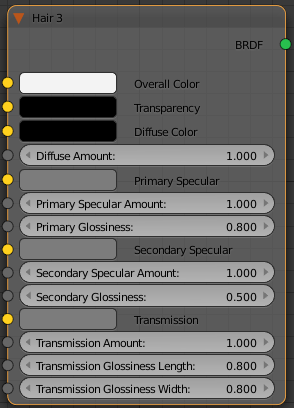This page provides information on the V-Ray Hair 3 material in Blender.
Overview
The Hair material is primarily designed for rendering hair and fur. The material is based around three components: a primary specular component, a secondary specular component, and a transmission component. A diffuse component is also provided for rendering of materials made up of cloth threads or other non-translucent fibers.
The primary specular component represents light that is reflected off the outer surface of a hair strand. The secondary specular component represents light that goes through the hair strand and is reflected off the back surface. The transmission component represents light that goes through the hair strand.
UI Path
||Node Editor|| > Add > BRDF > Hair 3
Node
Overall Color - a common color multiplier for all color components in the material (except for opacity). Used to easily change the look of the entire hair material.
Transparency - controls the transparency of the material.
Diffuse Color - controls the diffuse component of the shader. Use this for materials made out of cloth threads or other non-translucent fibers, as well as for dirty hair. Note that clean hair or fur does not normally have a diffuse component, so in that case leave the parameter black.
Diffuse Amount - the amount for the diffuse component of the material.
Primary Specular - the primary specular color component. Normally this is dark gray.
Primary Specular Amount - a multiplier for the primary specular color.
Primary Glossiness - the glossiness for the primary specular component. Values closer to 1.0 make the hair more shiny and sleek. Lower values give it a matted look.
Secondary Specular - the color of the secondary specular component. If Lock to Secondary is enabled, this value is ignored and the secondary specular color is derived from the transmission color.
Secondary Specular Amount - a multiplier for the secondary specular component. If Lock to Secondary is enabled, this value is ignored and the secondary specular amount is derived from the transmission amount.
Secondary Glossiness - the glossiness for the secondary specular component. Values closer to 1.0 correspond to shiny and sleek hair. Lower values correspond to matted hair.
Transmission - the color for the transmission component. When Lock to Transmission is enabled, this color determines the overall hair color.
Transmission Amount - the amount of the transmission component.
Transmission Glossiness Length - the glossiness of the transmission along the hair strand length. See the Examples for a demonstration of the effect of this parameter.
Transmission Glossiness Width - the glossiness for the transmission component across the hair strand width. See the Examples for a demonstration of the effect of this parameter.
The transmission component of the Hair 3 material is stored in the Refraction render element.
Parameters
Secondary Lock To Transmission - if this is enabled (the default), the color for the secondary specular component is derived from the color of the transmission component. Since a ray of light goes twice through the hair width, the color of the secondary specular component can be computed by multiplying the transmission color with itself. When this option is enabled, the hair color is mostly determined by the transmission color component.
Opaque for Shadows - when this is enabled, the hair material is always opaque for shadow calculations. This speeds up the rendering of transparent hair.
Opaque for GI - when this is enabled, the hair material is always opaque for GI calculations. This speeds up the rendering of transparent hair.
Simplify for GI - when enabled, a simplified diffuse version of the BRDF is used for GI calculations. This may speed up the rendering of hair but may significantly change the final look.
Use Cached GI - this option is similar to the Use Irradiance Map option for the VRayMtl material; if it is disabled, the hair material will always be calculated with brute force GI.




